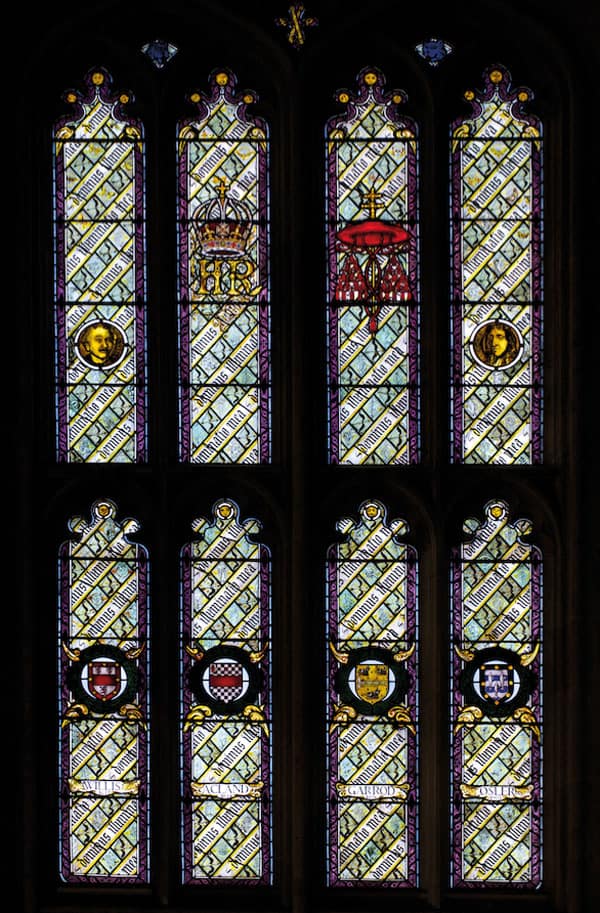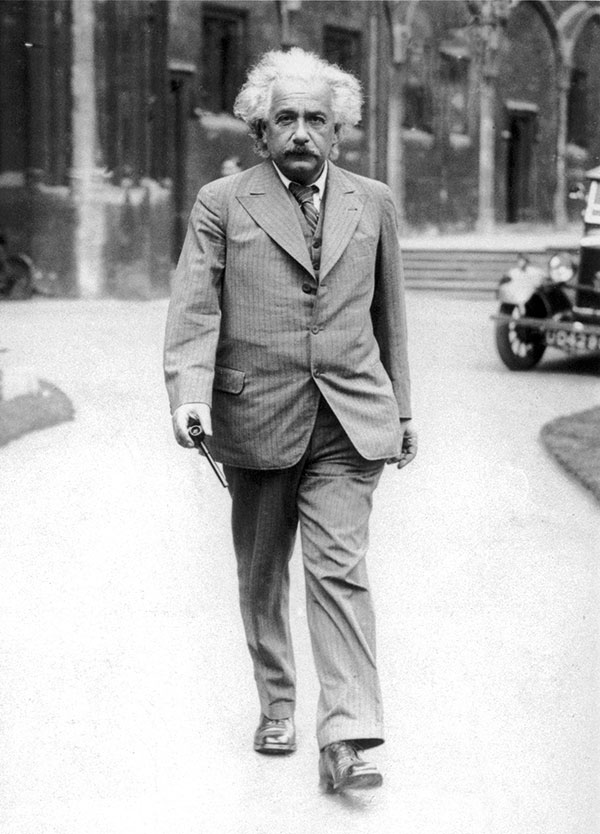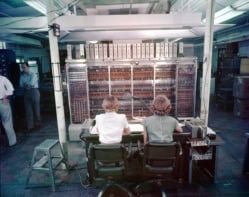Amid growing political unrest in Germany, Albert Einstein paid three short visits to Oxford in the early 1930s. Andrew Robinson reveals why this celebrated physicist travelled to Britain and how Einstein seduced – and then shocked – his audiences with his new thinking about how science works

The History of Science Museum in Oxford contains 18,000 objects, ranging from an ancient Roman vertical disc sundial to an X-ray spectrometer built by the physicist Henry Moseley in 1913. Its most famous object, however, is a humble Oxford blackboard – chalked by Albert Einstein on 16 May 1931 with calculations about the size, density and age of the universe. The museum’s website describes it as “a relic of a secular saint”, adding that some visitors “treat it almost as an object of veneration, anxiously requesting its location on arrival and eager to experience some connection with this near-mythical figure of science”.
The blackboard is perhaps the most lasting legacy of a visit that Einstein paid to Oxford in the spring of 1931. He had been to the city once before, having dropped by briefly in 1921 during his first visit to Britain. That was shortly after British astronomers had observed the 1919 solar eclipse, confirming Einstein’s general theory of relativity and propelling him to fame. On that occasion, he and his second wife, Elsa, were in Oxford for just a few hours, having a guided tour of the city and university provided by Einstein’s admirer Frederick Lindemann. A fellow German-born physicist, Lindemann was at the time head of the Clarendon Laboratory at Oxford and later rose to fame as Winston Churchill’s science adviser.
Einstein’s return in 1931 was also due to Lindemann, who had been courting the great man on behalf of the Oxford-based Rhodes Trust, which wished to launch a series of lectures in memory of the businessman and South African politician Cecil Rhodes. Einstein, who hardly spoke English, had already declined a previous invitation in July 1927, in part because he felt that his poor health – triggered by overwork and an inadequate diet in Berlin during the rigours of the First World War – would make “a long stay in foreign and unfamiliar surroundings…too great a burden for me, particularly bearing in mind the language difficulty”.
But shortly afterwards he changed his mind, telling Lindemann in August 1927: “It is very important to me that in England, where my work has received greater recognition than anywhere else in the world, I should not give the impression of ingratitude.” Other difficulties intervened, but at long last, after Lindemann saw Einstein personally in Berlin in 1930, he agreed to lecture, and to stay at Lindemann’s Oxford college, Christ Church. And so it was that on 1 May 1931, Einstein arrived from Berlin at Southampton docks, where he was collected by Lindemann and driven to Oxford in his chauffeured Rolls-Royce.
Lectures, blackboards and language barriers
Einstein stayed in Oxford until 27 May 1931, giving three lectures. The first took place on Saturday 9 May at Rhodes House to an overflowing audience made up of university staff, their companions and 500 students picked from a wide range of disciplines, not just science. Given in German without notes but with a blackboard, its English title was simply “The theory of relativity”. The second lecture, on 16 May, dealt with relativity and the expanding universe: a subject then in great flux. It required “two blackboards, plentifully sprinkled beforehand in the international language of mathematical symbol”, the Times reported. Einstein’s third lecture, delivered on 23 May, tackled his constantly evolving unified field theory – or, as Nature announced it, offered “An account of his attempt to derive both the gravitational and electromagnetic fields by the introduction of a directional spatial structure.”
The lectures’ scientific content was of no lasting significance, since it either repeated Einstein’s existing published work on relativity or was quickly rendered redundant by his (and others’) subsequent ideas. More interesting is the reaction of the very mixed Oxford audience to such an unparalleled educational-cum-social occasion. In a report of Einstein’s first lecture at Rhodes House, the Oxford Times noted how the front of the hall was filled by college principals, with younger members of the university seated at the back and in the gallery. In particular, it said, “women in large numbers flocked to hear Prof. Einstein speak”.
Unfortunately, no interpreter was provided, prompting the paper to wonder “how many of those who were present thoroughly understood German, or if they could understand the language in which Prof. Einstein spoke, how many of them could follow the complexities of relativity”. Einstein appeared, though, to do his best. A second report in the Oxford Times – concerning his final lecture – noted how Einstein drew not only equations but a diagram, “gesticulat[ing] helpfully in curves with the chalk to explain it [and turning] repeatedly from his audience to the board and back”.
Although the newspaper went on to note that “the better-informed members of the audience were kept busy taking [the equations] down”, at least one less-informed member found it hard to keep up. Seated in the front row, directly opposite the speaker, was Henry Julian White – the dean of Christ Church. A biblical scholar in his 70s, he slept soundly during the entire lecture. This amused Einstein, who perhaps also learnt a lesson. After one of the lectures he reportedly remarked, in his curiously stilted English, that the next time he had to lecture in Oxford, “the discourse should be in English delivered”.
Einstein’s Oxford blackboards

The idea of preserving Einstein’s blackboards during his visit to Oxford in 1931 seems to have come from dons who had attended his three public lectures, notably Robert Gunther, who had founded the History of Science Museum in Oxford a few years earlier. They rescued the two blackboards from Einstein’s 16 May lecture about the expansion of the universe. Although one board was later accidentally wiped in the museum’s storeroom, the other survives.
Whether Einstein would have approved or not, this blackboard neatly summarizes his cosmology paper of April 1931. Based on Alexander Friedmann’s relativistic model of an expanding cosmos, it set the cosmological constant to zero and used Edwin Hubble’s measurements of the expanding universe to estimate three quantities: the density of matter (ρ), the radius of the cosmos (P) and the timespan of the cosmic expansion (t). Note that “L.J.” is a German abbreviation for Licht Jahre, meaning “light-years”.
However, its arithmetic is not totally accurate. According to Cormac O’Raifeartaigh, a physicist from Waterford Institute of Technology in Ireland, “Einstein stumbled in his use of the Hubble constant, resulting in a density of matter that was too high by a factor of 100, a cosmic radius that was too low by a factor of 10 and a timespan for the expansion that was too high by a factor of 10.” The correct figures should have been: ρ ∼ 10–28 g/cm3, P ∼ 109 light-years and t ∼ 109 years.
Here, possibly, was one reason why Einstein did not favour the blackboards’ preservation. He certainly resisted any publication of his 1931 lectures by an eager Oxford University Press, on the grounds that – as he frankly told the warden of Rhodes House in 1933 – “he had since discovered that everything he had put forward in the lectures was untrue”.
Einstein’s blackboards proved a source of friction between him and the university (see box above). On 16 May 1931 he told his diary (in German) with real annoyance: “The lecture was indeed well-attended and nice. [But] the blackboards were picked up. (Personality cult, with adverse effect on others. One could easily see the jealousy of distinguished English scholars. So I protested; but this was perceived as false modesty.) On arrival [at Christ Church] I felt shattered. Not even a carthorse could endure so much!”
Dons, dinners and doggerel
A week later, on 23 May 1931, the University of Oxford awarded Einstein an honorary doctorate in a ceremony at the Sheldonian Theatre. Unlike his lectures, it passed without incident, even though Einstein did not seem too impressed with the address given in Latin by A B Poynton, an Oxford classicist and future college principal who knew little physics. Einstein noted in his diary that the speech was “serious, but not wholly accurate” – a remark he must have based on a translation, since he did not know Latin. However, Einstein’s face did light up when he heard reference to “Mercurius”, whose planetary position played a key role in efforts to confirm general relativity.
This personal reaction had been noted by Margaret Deneke, a musicologist with German roots who was associated with Oxford’s first women’s college, Lady Margaret Hall. Not only was she musical, she was also fluent in German – two characteristics that immediately endeared her to Einstein, who got to know her soon after his arrival. Indeed, following a somewhat strained formal dinner at Rhodes House the evening before his second lecture, Deneke joined Einstein and another guest in a musical trio. With his violin tucked under his chin, Einstein “threw himself wholeheartedly into the music”, according to Deneke’s diary, as the onlookers “smoked in silence, witnessing their guest of honour having a happy evening”. Einstein’s own diary was more frank, claiming “the guests hastily left the room” after the music began.
As for Christ Church, Einstein’s relationship with the college proved amiable but eccentric
As for Christ Church, Einstein’s relationship with the college proved amiable but eccentric. In his diary, he described the dinner-jacketed and gowned Christ Church dons dining in their great hall as “the holy brotherhood in tails” (“der heiligen Brüderschaar im Frack”). One of them, economist Roy Harrod, later recalled how Einstein had sat next to him at a meeting of their governing body. “We had a green baize table-cloth; under cover of this he held a wad of paper on his knee, and I observed his pencil was in incessant progress, covering sheet after sheet with equations.”


Einstein even wrote a poem in a don’s visitors’ book, which was later donated to the Bodleian Library in Oxford. It concerns Robert Hamilton Dundas, a classical scholar at Christ Church whose rooms Einstein occupied while Dundas was out of the country on a world tour. Dundas discovered the poem after his return to Oxford in 1932, when he got to meet Einstein. Although the poem might be dismissed as mere doggerel, it is nonetheless thoughtful and witty. It was later published in the Times following Einstein’s death in 1955, with his rhymed German having been translated by the Oxford literary scholar James Blair Leishman. The poem includes the lines:
Shelves of towering folios
Meditate in solemn rows;
Find it strange that one can dwell
Here without their aid so well.
Charisma and connections
On the whole, though, Einstein’s most fruitful Oxford meetings took place outside Christ Church, in settings ranging from other colleges and university societies to private houses and more informal gatherings. Einstein “threw himself into all the activities of Oxford science, attended the colloquiums and meetings for discussions, and proved so stimulating and thought-provoking that I am sure his visit will leave a permanent mark on the progress of our subject”, Lindemann wrote in June 1931, after Einstein had returned to Berlin.
“Combined with his attractive personality,” he went on, “[Einstein’s] kindness and sympathy have endeared him to all of us and I have hopes that his period as Rhodes lecturer may initiate more permanent connections with this university which can only prove fertile and advantageous in every respect.” What Lindemann underplayed, however, was the fundamentally experimental orientation of science at Oxford in 1931. There were hardly any theorists who could discuss physics and mathematics at Einstein’s level – if anything, he might have been more suited to the University of Cambridge, which was home to the astronomer Arthur Eddington who had led the 1919 solar-eclipse expeditions that “proved” general relativity.
Perhaps the most evocative Oxford memory of Einstein concerned simply his charisma. It was recalled by William Golding – the future author of Lord of the Flies, who started as an undergraduate in science before changing to literature (and went on to win a Nobel prize for his writing). Some time in 1931, Golding was standing on a small bridge in Magdalen Deer Park looking at the river when a “tiny moustached and hatted figure” joined him. “Professor Einstein knew no English at that time, and I knew only two words of German. I beamed at him, trying wordlessly to convey by my bearing all the affection and respect that the English felt for him.”
For about five minutes the pair stood side by side. At last, said Golding, “With true greatness, Professor Einstein realized that any contact was better than none.” He pointed to a trout wavering in midstream. “Fisch,” he said. “Desperately I sought for some sign by which I might convey that I, too, revered pure reason. I nodded vehemently. In a brilliant flash I used up half my German vocabulary: ‘Fisch. Ja. Ja.’ I would have given my Greek and Latin and French and a good slice of my English for enough German to communicate. But we were divided; he was as inscrutable as my headmaster.” For another five minutes, the unknown undergraduate Englishman and the world-renowned German scientist stood together. “Then Professor Einstein, his whole figure still conveying goodwill and amiability, drifted away out of sight.”
Refugee from Nazi Germany
After his visit to Oxford in 1931, Einstein was elected a “research student” (i.e. a fellow) of Christ Church on an annual stipend of £400, which was to run until 1937, in exchange for brief periods of residence each year more or less at his convenience. This arrangement had been proposed by Lindemann, probably in the hope that Einstein would settle in Oxford, though in the event he returned on only two further occasions.
Einstein’s next visit, from April to May 1932, was less eventful. He avoided giving any Oxford lectures, though he did travel to Cambridge to deliver the Rouse Ball lecture on mathematics on 5 May, which provided a welcome opportunity to meet Eddington.
Back home in Germany, however, May 1932 was proving dangerously eventful, with a secret deal struck between an influential German military leader and the upcoming Adolf Hitler. It was the start of the slide towards the Nazi seizure of power, and in March 1933 Einstein found himself permanently exiled from his native country – an event that propelled him back to Oxford for his final stay in May–June 1933. As he informed his fellow-physicist Max Born – who had just escaped from Germany himself and would soon settle in Britain – in a letter written on 30 May from the cloistered calm of Christ Church: “I’ve been promoted to an ‘evil monster’ in Germany, and all my money has been taken away from me. But I console myself with the thought that the latter would soon be gone anyway.”
During a public event at Oxford’s University Museum of Natural History on 2 June 1933, Einstein appeared sorely in need of public reassurance. He had been invited to offer a vote of thanks for a lecture given by Ernest Rutherford to the Junior Scientific Society. Not only was Rutherford a Nobel laureate, like Einstein, he was also a peer of the realm, the 1st Baron Rutherford, and, in addition to his honours, a big booming extrovert. According to an Oxford undergraduate present, C H Arnold, Einstein seemed “a poor forlorn little figure” beside Rutherford. While Einstein was delivering his speech of thanks, somehow coping with English, “it seemed to me that he was more than a little doubtful about the way in which he would be received in a British university”.
However, the moment he sat down, Einstein was greeted by thunderous applause. As Arnold recalled more than three decades later: “Never in all my life shall I forget the wonderful change which took place in Einstein’s face at that moment. The light came back into his eyes, and his whole face seemed transfigured with joy and delight when it came home to him in this way that, no matter how badly he had been treated by the Nazis, both he himself and his undoubted genius were at any rate greatly appreciated at Oxford.”
Mathematics, physics and reality

The psychological strain seems to have expressed itself in Einstein’s scientific thinking as well as his personal behaviour. In his final Oxford lecture, “On the method of theoretical physics”, given at Rhodes House on 10 June 1933, he tried to escape from the messy physical reality inherent in experimental physics, including quantum mechanics, and substitute the paradise of pure mathematics, which he had been pursuing for some years in his unified field theory. Indeed, Einstein’s scientific biographer Abraham Pais, a physicist who knew Einstein well, later hailed this controversial lecture as “perhaps the clearest and most revealing expression of his mode of thinking”.
Reading from a fluent translation of his original German, made for him by three Christ Church dons – Gilbert Ryle (a philosopher), Denys Page (a classicist) and Claude Hurst (a physicist) – Einstein initially reassured his Rhodes House audience, many of whom were no doubt classically trained, that he saw ancient Greece as “the cradle of western science”. The Greeks, he said, had “created the intellectual miracle of a logical system, the assertions of which followed one from another with such rigour that not one of the demonstrated propositions admitted of the slightest doubt – Euclid’s geometry”.
Yet for science to comprehend reality, Einstein continued, scientists conventionally argued that more than Greek thought was required. “Pure logical thinking can give us no knowledge of the world of experience,” he said. “All knowledge about reality begins with experience and terminates in it.” Einstein duly hailed Galileo as “the father of modern physics and indeed of the whole of modern natural science”, before praising Newton for being “the first creator of a comprehensive and workable system of theoretical physics”.
Then, however, Einstein remarkably switched tack. General relativity, he said, had shown the conventional view to be wrong. “For this theory revealed that it was possible for us, using basic principles far removed from those of Newton, to do justice to the entire range of the data of experience in a manner even more complete and satisfactory than was possible with Newton’s principles.” Therefore, he said: “Pure mathematical construction enables us to discover the concepts and the laws connecting them which give us the key to the understanding of the phenomena of nature.” His conclusion: “Experience of course remains the sole criterion of the serviceability of a mathematical construction for physics, but the truly creative principle resides in mathematics. In a certain sense, therefore, I hold it to be true that pure thought is competent to comprehend the real, as the ancients dreamed.”
Einstein assured his Oxford audience – and by extension the international world of physics – that mathematics, on its own, could provide the basis for understanding nature
Thus Einstein assured his Oxford audience – and by extension the international world of physics – that mathematics, on its own, could provide the basis for understanding nature. He apparently now rejected his own earlier position, which he had elegantly stated in 1921, that: “As far as the laws of mathematics refer to reality, they are not certain; and as far as they are certain, they do not refer to reality.” General relativity, he now claimed, had been essentially based on mathematical concepts rather than physical observations – for all its crucial confirmation by astronomers in 1919.
No doubt many theoretical and experimental physicists, especially those working in quantum mechanics, were taken aback and unconvinced by such a bold claim. After all, it flew in the face of so much of the history of physics, which evidently arose from a combination of theory, observation and experiment. But very few of them were in a position to contest its validity with general relativity’s creator, whether in Oxford in June 1933 or after Einstein left Europe forever in October, heading for Princeton. There, in the US, away from Nazi persecution, he was free to pursue his Oxford claim by developing his unified field theory for the rest of his uniquely influential life.



